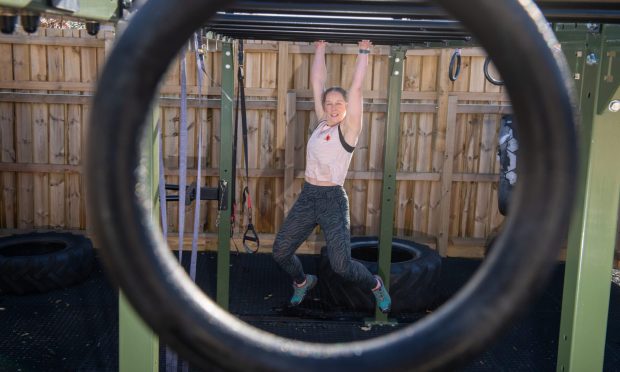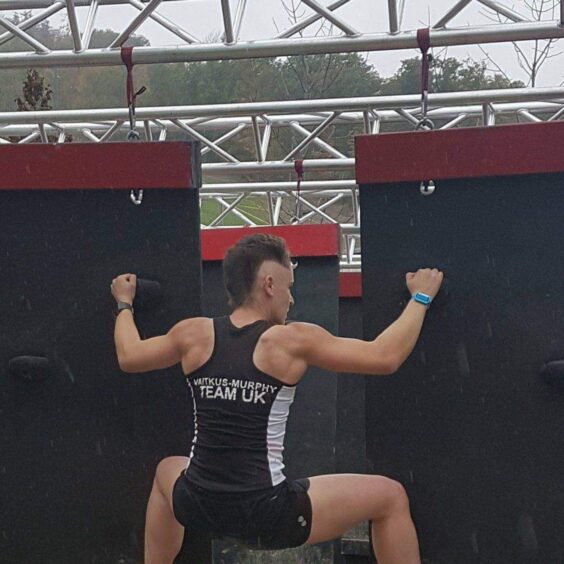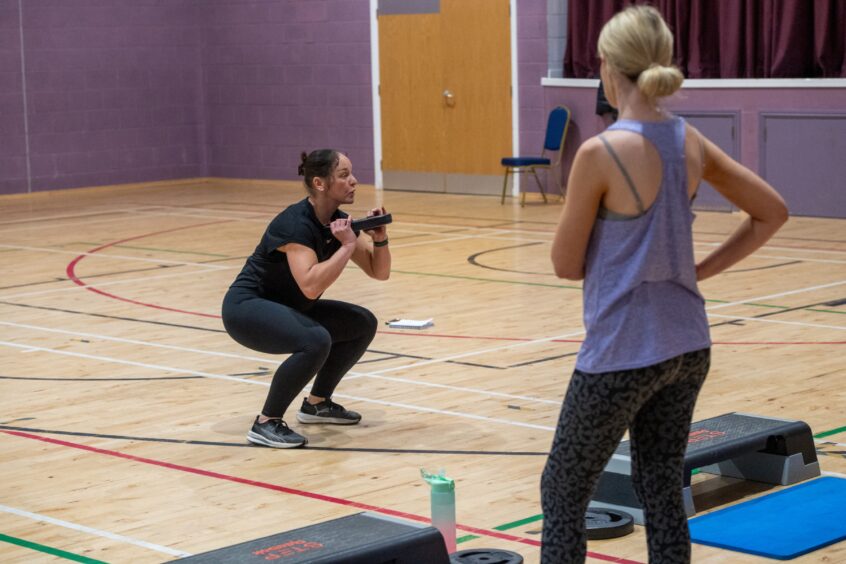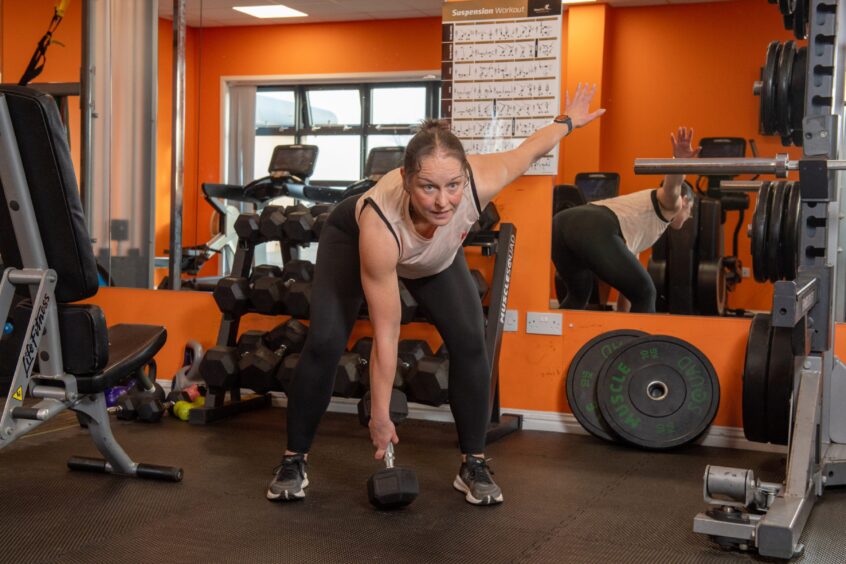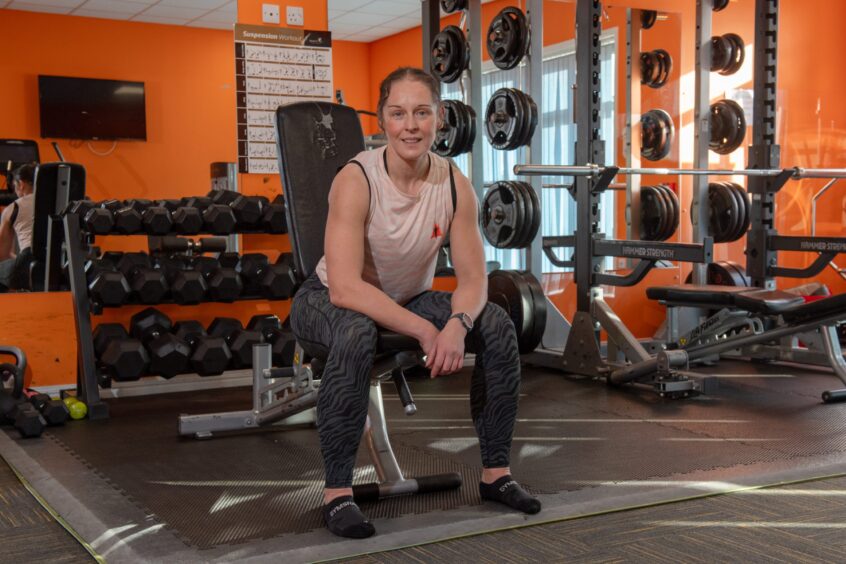Leanne Vaitkus-Murphy is used to overcoming obstacles.
After all, she’s competed in the Obstacle Course Race World Championships and completed numerous Tough Mudders, the obstacle race that sees competitors crawl under barbed wire and ford waist-deep through freezing water.
But her biggest challenge came when, at the age of just 39, she was forced to have a full hip replacement after being diagnosed with osteoarthritis.
Amazingly, Leanne, who works as a personal trainer and as a manager at the Axis Centre in Newmachar, took the operation in her stride.
Just ten days after going under the knife she was back at work leading a spin cycle class.
After that she restarted training, slowly at first but quicker every day.
And, as our pictures taken at the end of October show, Leanne is racing back to full strength just weeks after her hip replacement, getting hands on with the obstacle race equipment at the Axis Centre, which is affiliated with British Obstacle Sports.
What’s her secret? It’s all about preparation, says the Maud native.
“What you go into that operation with, you’re going to come out with, but a little bit worse,” Leanne explains.
“You’re not going to magically grow muscles, so you have to go into it as strong as you can. That’s what I did.”
The fitness fanatic with the ‘unlucky’ hip
Leanne’s hip replacement journey started in lockdown when she began to get serious pain in her side.
“Their exact words at the NHS were ‘You’re just unlucky’,” she recalls.
“It was the osteoarthritis but it wasn’t exercise related. It might have been something to do with the shape of my hip socket, so just the way I was born.”
That came as a relief to Leanne because her whole life she had been active.
Born in Adelaide, Australia, she moved to Scotland when she was six and enjoyed moving her body in all sorts of way. She went to dancing college and eventually became a fitness coach.
Through Tough Mudder, she got into the crazy world of competitive obstacle racing, competing at the top level in three world championships. From 2018 on, the fitness fanatic took it – comparatively – easy by going back to Tough Mudder.
The crazy world of Tough Mudder racing
Many people would question the sanity of those doing Tough Mudder, which loves to push competitors to the limits by making them race over a series of fiendish obstacles.
But Leanne loved it, competing against others in her age group over a season of races.
The courses are usually a choice of 5, 10 or 15 kilometres in length, with different obstacles in the way.
A 15-kilometre race takes about four hours to finish. However, Leanne has done a few of the even more insane events.
“I’ve done Europe’s Toughest Mudder,” Leanne says. “That’s 12 hours overnight. And last year I did what’s called the Unholy Grail, which is 20 kilometres on the Saturday morning and then overnight you do another 40 kilometres. On Sunday morning you do 20 kilometres again.
“I don’t think I slept at all,” she continues with a laugh. “There was the opportunity to sleep on the Saturday afternoon but you can’t because there’s too much going on.”
As to why she does it, Leanne says: “It hooks you in. You get addicted, you just want to push yourself harder and harder and try new things.”
‘It was scary to think I might not run again”
As the hip operation loomed, Leanne didn’t slow down. She wanted to be as strong as possible going into surgery, so her Tough Mudder schedule actually increased.
But there was another reason she did almost every race she could ahead of the op. She was scared they might be her last.
“It was quite terrifying to think I might not be able to do everything that I’d been doing up to that point,” she says.
“But I knew my arthritis was only going to get worse and worse and worse. If I didn’t do anything, it might have gotten to the point where I’d end up in a wheelchair or with walking aids, and then I’m not going to be doing those things anyway.
“But it was scary to think, well, what if I can’t ever run again?”
How doctors cut through Leanne’s muscle to replace hip
With those thoughts rattling around her head, she went to Inverness for surgery on Tuesday October 3.
Doctors cut through the glute muscles and fitted a ceramic hip, a newer type of artificial joint that lasts longer than titanium ones, sometimes up to 20 years.
They then stitched and glued her muscles back together and sent her on her way.
“Initially, the first few days, I was like, I’ve made a massive mistake,” Leanne remembers. “I couldn’t even move my leg out to the side, it just felt like a dead weight.
But soon her strength returned. She worked hard at her physio – as a fitness coach she was unsurprisingly good at it – and got stronger and stronger.
“it’s just amazing how fast you can recover,” she says.
On day 10, she was scheduled to lead a spin class at the Axis Centre. She intended to just sit on the bike at the front but gave the pedals a couple of turns.
“I was like, oh no, I feel great. I’ll just do the whole cycle on the bike.”
What Leanne didn’t know was that, one of the class members was a physio. At the end, she came up to Leanne, who thought she was about to get a telling off for putting her new hip at risk.
“But she was like, ‘You’re doing amazing. You’re obviously strong enough, you know, you’re strong enough, it was pain free, so just carry on with what you’re doing’.”
Getting back to Tough Mudder fitness after hip replacement
After that, there was no stopping her.
The next day she started doing modified movements – workouts such as backrows and hand cleans that didn’t put pressure on her hip. She keep at it, knowing that any kind of movement was strengthening her leg.
A month on from the op, the hard work is paying off.
“I can stand on one leg quite comfortably now, which most people at this stage probably couldn’t do,” she says.
“I mean, a lot of people can’t stand on one leg anyway.”
How to recover faster from hip replacement surgery
Leanne knows not everyone can be as fit as her ahead of a hip replacement. But she’s adamant that any exercise will benefit patients.
She has seen it before through her own coaching of older adults and people with conditions such as Parkinson’s disease.
“People get told they need hip replacements, and they just stop exercising,” she says. “If you go in really, really deconditioned you’re going to come out still really deconditioned plus even weaker.”
Meanwhile, Leanne is feeling better every day. She is delighted with her new – pain-free – hip and is already planning her next Tough Mudder.
“April will be the next one for me,” she says. “I might not do it competitively next season, but maybe by the year after I’ll be feeling ready to get back on the competitive scene.”
